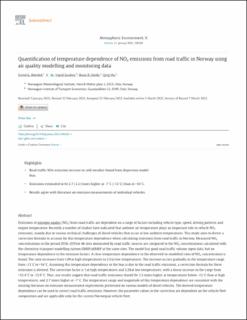| dc.contributor.author | Wærsted, Eivind Grøtting | |
| dc.contributor.author | Sundvor, Ingrid | |
| dc.contributor.author | Denby, Bruce | |
| dc.contributor.author | Mu, Qing | |
| dc.coverage.spatial | Norway, Oslo | en_US |
| dc.date.accessioned | 2023-06-14T11:02:18Z | |
| dc.date.available | 2023-06-14T11:02:18Z | |
| dc.date.created | 2022-04-28T12:51:51Z | |
| dc.date.issued | 2022-03-05 | |
| dc.identifier.issn | 2590-1621 | |
| dc.identifier.uri | https://hdl.handle.net/11250/3071323 | |
| dc.description | Published by Elsevier Ltd. This is an open access article under the CC BY license (http://creativecommons.org/licenses/by/4.0/) | en_US |
| dc.description.abstract | Emissions of nitrogen oxides (NOx) from road traffic are dependent on a range of factors including vehicle type, speed, driving patterns and engine temperature. Recently a number of studies have indicated that ambient air temperature plays an important role in vehicle NOx emissions, mainly due to various technical challenges of diesel vehicles that occur at low ambient temperatures. This study aims to derive a correction formula to account for this temperature dependence when calculating emissions from road traffic in Norway. Measured NOx concentrations in the period 2016–2019 at 46 sites dominated by road traffic sources are compared to the NOx concentrations calculated with the chemistry-transport modelling system EMEP/uEMEP at the same sites. The model has good road traffic volume input data, but no temperature dependence in the emission factors. A clear temperature dependence in the observed-to-modelled ratio of NOx concentration is found. The ratio increases from 1.09 at high temperatures to 2.9 at low temperatures. The increase occurs gradually in the temperature range from -13 °C to +14 °C. Assuming this temperature dependence in the bias is due to the road traffic emissions, a correction formula for these emissions is derived. The correction factor is 1 at high temperatures and 3.28 at low temperatures, with a linear increase in the range from +12.4 °C to -12.9 °C. Thus, our results suggest that road traffic emissions should be 3.3 times higher at temperatures below -13 °C than at high temperatures, and 2.7 times higher at -7 °C. The temperature range and magnitude of this temperature dependence are consistent with the existing literature on emission measurement experiments performed on various models of diesel vehicles. The derived temperature dependence can be used to correct road traffic emissions. However, the parameter values in the correction are dependent on the vehicle fleet composition and are applicable only for the current Norwegian vehicle fleet. | en_US |
| dc.language.iso | eng | en_US |
| dc.publisher | Elsevier Ltd | en_US |
| dc.rights | Navngivelse 4.0 Internasjonal | * |
| dc.rights.uri | http://creativecommons.org/licenses/by/4.0/deed.no | * |
| dc.subject | NOx | en_US |
| dc.subject | Low temperature emissions | en_US |
| dc.subject | Road traffic exhaust emissions | en_US |
| dc.title | Quantification of temperature dependence of NOx emissions from road traffic in Norway using air quality modelling and monitoring data | en_US |
| dc.title.alternative | Quantification of temperature dependence of NOx emissions from road traffic in Norway using air quality modelling and monitoring data | en_US |
| dc.type | Journal article | en_US |
| dc.type | Peer reviewed | en_US |
| dc.rights.holder | © 2022 The Authors. | en_US |
| dc.source.articlenumber | 100160 | en_US |
| dc.description.version | publishedVersion | en_US |
| cristin.ispublished | true | |
| cristin.fulltext | original | |
| cristin.qualitycode | 1 | |
| dc.identifier.doi | 10.1016/j.aeaoa.2022.100160 | |
| dc.identifier.cristin | 2019800 | |
| dc.source.journal | Atmospheric Environment: X | en_US |
| dc.source.volume | 13 | en_US |
| dc.source.issue | Januar 2022 | en_US |
| dc.source.pagenumber | 1-13 | en_US |
| dc.relation.project | Statens Vegvesen: Luftkvalitet | en_US |

